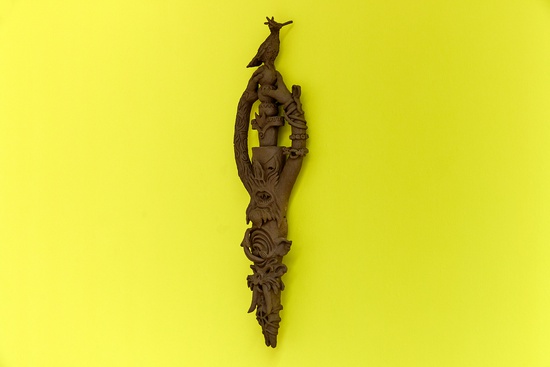8. Mittere and Resurrection
Sharon van Overmeiren
(2019)
A giant, talismanic hand is posed in a blessing gesture. Fuzzy creatures cling to its digits; microscopic snakes tangle around the thumb and a tiny baby is swaddled in the centre of its palm. Speaking to the morbid but holy power of dismembered body parts, this hand brings to mind medieval reliquaries—silver arm shrines that contain the shrivelled remains of early saints. Carved with such abundant imagery, like tattoos in relief, we can’t help but wonder if the hand is here to bless us, or whether it has wriggled free from the ground, zombie style. Elsewhere, totemic clay forms are stacked on top of one another: composites of grotesque faces, crosses, orbs, small birds, tusked animals that cling to one another in an agitated state.
These quasi-archeological objects are ‘fictional sculptures’ by Sharon Van Overmeiren. Reminding us that shaping an object in clay is always an act of communication with the ground, these ceramic objects are an earthy, sodden brown. They bring to mind the expression nostalgie de la boue—literally ‘nostalgia for the mud’, a thirst for crude or regressive forms. Other objects feel aquatic, with gargoyle faces and snarling water spirits gushing out from vessels, or splashes of sea foam rising decadently forth. Long considered a ‘craft’ rather than an ‘art’, ceramics have always had a utilitarian bent, lending themselves to the carrying of water and the storing of food. As such, they are seen as markers of ‘civilisation’, deeply ingrained into society, vital for cultivation, preservation and the home, but historically lacking the cultural gravitas of a sculpture carved from marble.
Conjuring the elemental energies of their primordial materials—fired earthen clay and water—Van Overmeiren’s idiosyncratic forms speak of shrines, relics, totems, fallen civilisations, archeological artefacts and fragments of culture; the kind of objects whose histories are pieced together by the colonial and taxonomic museologists’ eyes. ‘Copying and pasting’ these forms with references from the constraint stream of imagery and information we encounter in the 21st-century, as well as from the expansiveness of the natural world, Van Overmeiren’s sculptures seek to liberate objects from hierarchies and categorisation. At the root of her work is an interest in storytelling, in human expression through symbols and fictions. Questioning facts and historical linearity, her sculptures seem to communicate with one another, as if sharing an inside joke we’re not privy to.
Text by Rosa Abbott


